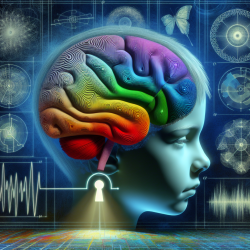Introduction
In the ever-evolving landscape of special education, understanding the neurophysiological underpinnings of Autism Spectrum Disorder (ASD) is crucial for developing effective interventions. A recent study titled "Linear and Non-linear Analyses of EEG in a Group of ASD Children During Resting State Condition" provides valuable insights into the brain activity of children with ASD. This blog explores how practitioners can leverage these findings to enhance their therapeutic approaches and encourages further research in this field.
Understanding the Research
The study analyzed the spontaneous electroencephalogram (EEG) brain activity of 14 children diagnosed with ASD, comparing them to 18 typically developing children aged 5–11 years. The researchers employed various measures, including Power Spectral Density (PSD), variability across trials (coefficient of variation: CV), and complexity (multiscale entropy: MSE), to assess the resting state EEG.
Key findings include:
- Increased PSD in fast frequency bands (high-beta and gamma) in children with ASD.
- Higher variability (CV) and lower complexity (MSE) in the ASD group compared to typically developing children.
- These results suggest more variable, less complex, and potentially less adaptive neural networks in children with ASD.
Implications for Practitioners
These findings have significant implications for practitioners working with children with ASD:
- Tailored Interventions: Understanding the increased variability and decreased complexity in neural networks can help practitioners design interventions that focus on enhancing neural adaptability and complexity.
- Early Detection: The study highlights the potential of using EEG as a non-invasive tool for early detection of ASD, which can lead to timely interventions.
- Holistic Approach: Incorporating neurophysiological assessments into therapeutic practices can provide a more comprehensive understanding of a child's unique needs and progress.
Encouraging Further Research
While the study provides valuable insights, it also opens the door for further research:
- Larger Sample Sizes: Future studies with larger sample sizes could validate these findings and provide more generalizable results.
- Longitudinal Studies: Long-term studies could explore how neural variability and complexity evolve over time in children with ASD.
- Integration with Behavioral Data: Combining EEG data with behavioral assessments could offer a more holistic view of ASD and its manifestations.
Conclusion
The study on EEG analyses in ASD children offers a promising avenue for enhancing therapeutic approaches and early detection methods. By understanding the unique neural patterns in children with ASD, practitioners can develop more effective, personalized interventions. Continued research in this area is essential for unlocking the full potential of neurophysiological assessments in special education.
To read the original research paper, please follow this link: Linear and Non-linear Analyses of EEG in a Group of ASD Children During Resting State Condition.










